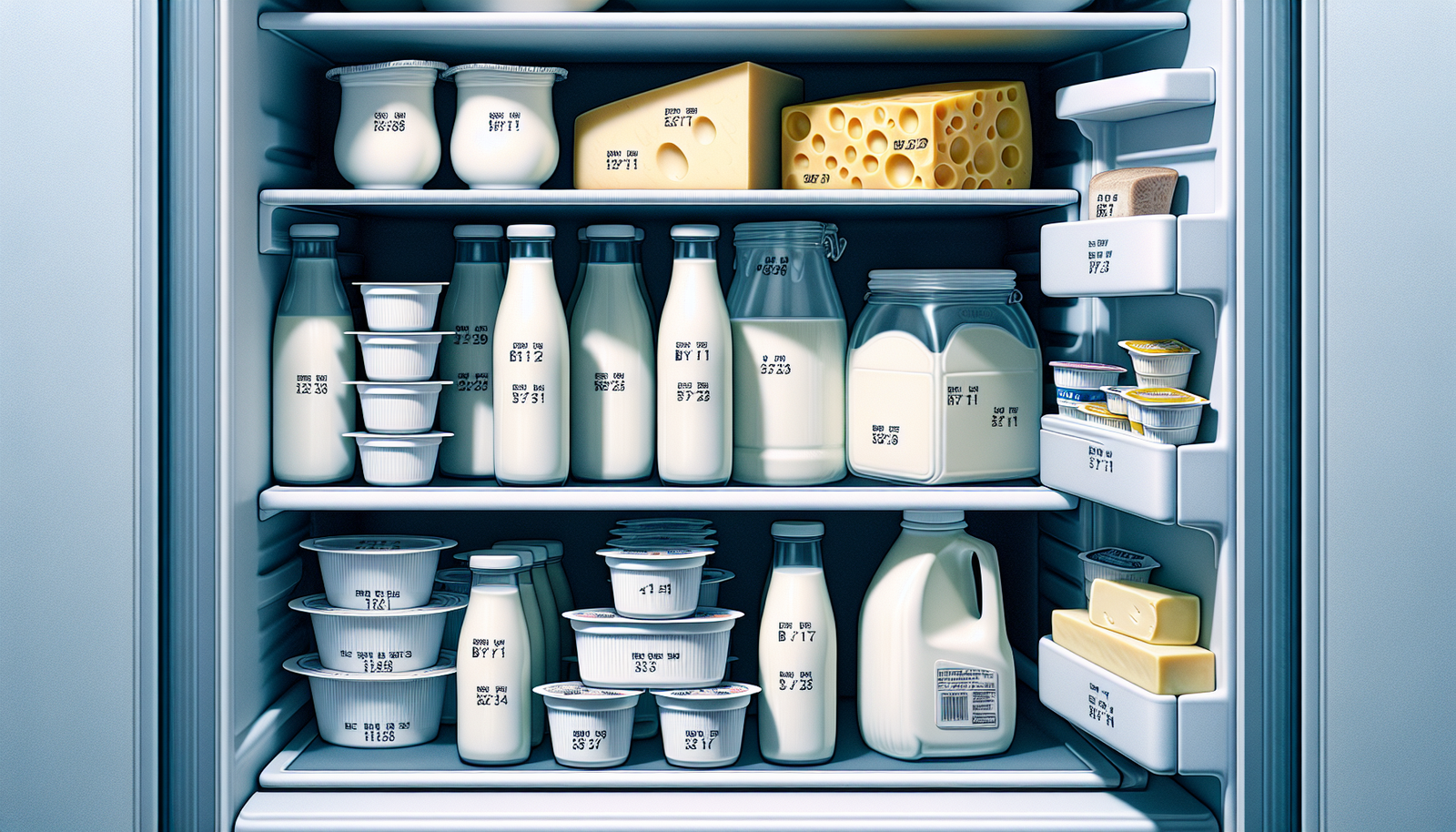
How to Store Dairy Products Safely for Longer Shelf Life
Dairy products are prone to spoilage, but with the right storage techniques, you can extend their shelf life. This article will guide you on how to store milk, cheese, butter, and other dairy items safely to keep them fresh and prevent waste.
Why Dairy Storage Matters
Proper dairy storage is crucial. It ensures the safety and quality of the products we consume. Understanding the impact of temperature, recognizing common storage mistakes, and identifying signs of spoiled products can make a significant difference. Let’s delve into the details and see how these aspects affect our dairy products.
How Temperature Affects Dairy Shelf Life
Temperature plays a key role in determining the shelf life of dairy products. Cold temperatures slow down bacterial growth, extending the freshness and safety of these items. It’s important to store milk and other dairy products in the coldest part of the refrigerator. The back of the fridge is often the best spot, far from warm air when the door is opened. Maintaining a consistent temperature below 40°F (4°C) is optimal for keeping dairy safe. Fluctuating temperatures can accelerate spoilage, so regular checks of your refrigerator’s settings are vital.
Failure to store dairy products at the right temperature can lead to rapid spoilage. This not only wastes money but can also pose health risks. It’s crucial to be vigilant about where and how you store these items. Investing in a refrigerator thermometer can help ensure your dairy is kept at a safe temperature.
Common Mistakes in Dairy Storage
Many people unwittingly make mistakes in dairy storage, leading to premature spoilage. One common error is leaving dairy products out of the fridge for extended periods. This can happen when unloading groceries or during meal preparation. Every minute spent outside refrigeration can shorten the lifespan of these products.
Another frequent mistake is failing to seal containers properly. Open packages allow exposure to air, speeding up spoilage. Additionally, placing dairy near foods with strong odors can lead to flavor contamination. It’s advisable to store dairy in airtight containers or sealed bags to maintain freshness and prevent cross-contamination.
Signs of Spoiled Dairy Products
Recognizing signs of spoilage is essential to prevent foodborne illnesses. Spoiled milk often smells sour and may develop a lumpy texture. Cheese can become hard, change color, or grow mold that isn’t part of its intended appearance. Spoiled yogurt may separate into layers or develop an off-putting smell.
Visual cues, like mold and discoloration, often accompany spoilage. However, always rely on your sense of smell and taste when in doubt. If a dairy product doesn’t smell right, it’s better to be safe and dispose of it. Consuming spoiled dairy can lead to food poisoning and other health issues.
Best Practices for Storing Dairy Products
Proper storage techniques can extend the life and quality of dairy products. Knowing the best ways to store milk, cheese, yogurt, and more ensures they stay fresh and tasty. Here are some expert tips to keep your dairy items in top condition.
Storing Milk and Cream
Milk and cream should always be stored in the refrigerator at or below 40°F (4°C). For optimal preservation, place them on a lower or middle shelf, not in the refrigerator door. The door’s temperature fluctuates more, which can cause spoilage. Once opened, milk should be consumed within 5-7 days, and cream within 3-5 days.
When storing milk, keep it away from foods with strong odors, as milk can absorb these smells. If you purchase milk in bulk, consider freezing it. Ensure there is room for expansion in the container, and use it within a month for best quality. Always thaw frozen milk in the fridge and shake well before using.
Proper Storage of Cheese
Cheese storage can vary depending on the type, but generally, it should be kept in the fridge. Hard cheeses like cheddar can be wrapped in wax paper or parchment, then placed in a plastic bag. Soft cheeses, such as brie, do well in airtight containers.
For cheeses with natural rinds, it’s best to allow them to breathe slightly to prevent mold growth. If mold appears on hard cheese, you can cut away the affected area. However, for soft cheese, it’s best to discard it. Cheese should be kept at a steady temperature and checked regularly for signs of spoilage.
How to Store Yogurt, Butter, and Other Dairy Items
Yogurt should be stored in the fridge and consumed by the expiration date. An airtight container helps maintain its freshness. Butter can be kept in the fridge or freezer, with unsalted butter lasting longer when frozen. If kept in the fridge, use within a month for best flavor. Frozen butter can be stored for up to six months.
Other dairy items, like sour cream and cottage cheese, should also be refrigerated and used within their expiration dates. If you open these products, aim to consume them within a week. Always use clean utensils to serve them to avoid contamination. Keeping a clean and organized fridge can help ensure all dairy items remain fresh and safe to consume.
Extending the Shelf Life of Dairy
Maximizing the shelf life of dairy goes beyond basic storage. Techniques like freezing and using airtight containers can significantly enhance longevity. Knowing how to interpret expiration dates ensures you’re making the most of your dairy products.
Freezing Dairy Products Safely
Freezing is an effective way to extend the life of dairy, but it requires proper technique. Milk can be frozen but should be consumed within a month for best results. Always leave room for expansion in the container. Thaw it in the fridge and shake well before use. Cheese can also be frozen, though it might change texture. Grated cheese freezes best, as it’s easy to use straight from the freezer.
Butter is another dairy product that freezes well. Wrap it in foil or freezer paper before placing it in a bag to prevent freezer burn. Sour cream and yogurt can be frozen, but they may separate upon thawing. Use them in cooking or baking rather than eating plain.
Using Airtight Containers for Dairy
Airtight containers are a game-changer for dairy storage. They help prevent exposure to air, which accelerates spoilage and contamination. Invest in quality, reusable containers or resealable bags for storing products like cheese, yogurt, and cream. Make sure the containers are clean and dry before use.
Using airtight containers also helps keep your fridge organized, making it easier to maintain a proper temperature. It minimizes the risks of spills and cross-contamination, helping to keep your dairy fresh for longer. Glass containers are ideal for storing dairy, as they don’t absorb odors and are easy to clean.
Understanding Dairy Expiration Dates
The expiration dates on dairy products can be confusing, but they are essential for food safety. “Sell by” dates indicate how long a store can display the product. “Use by” or “best by” dates suggest when the product will be at its peak quality. These dates are not always definitive indicators of spoilage.
Trust your senses as well as the dates. If a product smells or tastes off, it’s better to err on the side of caution. Keeping track of when items were opened can also help manage their shelf life. By understanding these dates and storing products correctly, you can maximize the freshness and safety of your dairy items.
Conclusion
Dairy products require careful storage to extend their shelf life and prevent spoilage. By following the best storage practices, you can keep your milk, cheese, butter, and other dairy items fresh for longer. Proper handling and refrigeration will ensure your dairy products remain safe and delicious for your everyday meals.
FAQ
How long can I store milk and cream in the fridge?
Milk typically stays fresh for 5-7 days after opening, while cream lasts about a week. Ensure they’re stored in a cool part of the fridge to maximize freshness.
Can I freeze cheese and other dairy products?
Certain cheeses freeze well, like hard and semi-hard varieties. Wrap them tightly before freezing. For other dairy, freezing can alter texture, so it’s best to check specific guidelines.
What’s the best way to store butter?
Keep butter in its original wrapper or an airtight container in the fridge. This prevents it from absorbing odors and keeps it fresh longer.
How do I prevent cheese from going moldy?
Wrap cheese in wax or parchment paper before placing it in a breathable container. Store in the cheese drawer or a cool section of the fridge to slow mold growth.
Should I store dairy products in the fridge door?
Avoid storing dairy in the fridge door, as temperatures fluctuate there. Place them on the shelves where temperatures remain steady and cooler.
How can I extend the shelf life of dairy products?
Consistently keep dairy products cold and use airtight packaging. Consider freezing items when appropriate, and always check expiration dates.











